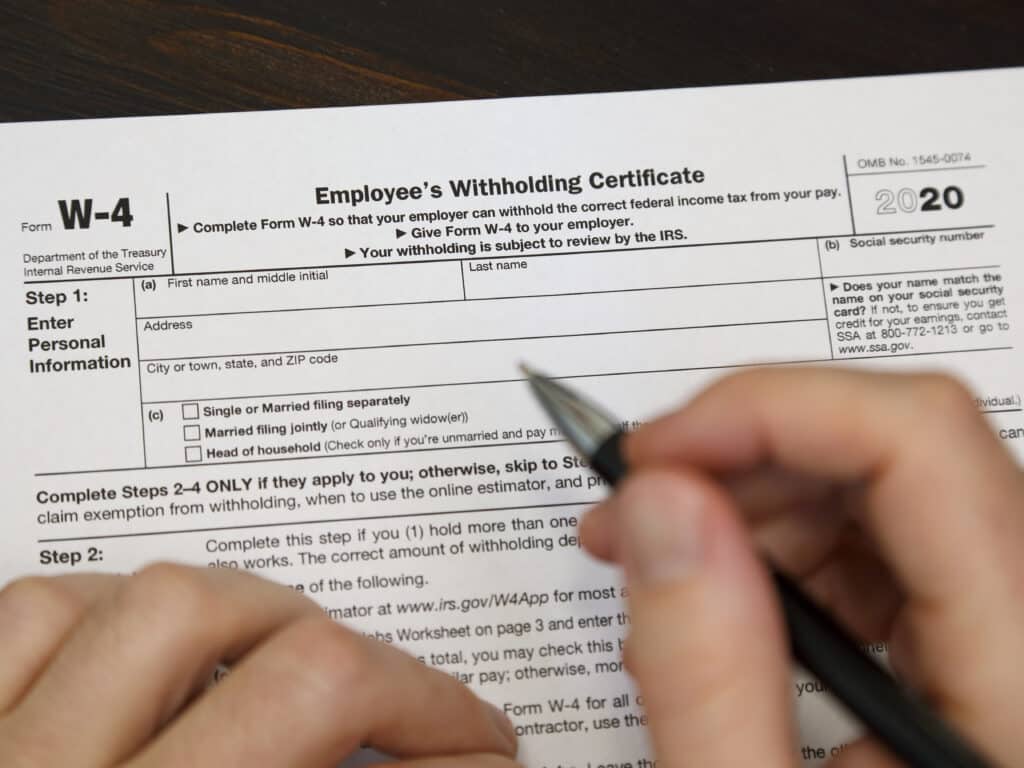How to Fill Out the New IRS Form W-4

If you’ve ever started a new job, you’ve probably filled out an IRS Form W-4 or the Employee’s Withholding Certificate. It’s a document that tells your employer how much federal income tax to withhold from your paycheck. This withholding helps ensure you pay the correct taxes throughout the year. The tax withheld from your paycheck is sent directly to the IRS and applied toward your annual income tax bill.
You must withhold the correct amount, as it can directly impact your take-home pay and tax return. If too little is withheld, you might face a big tax bill when you file your return. If too much is withheld, you’ll get a larger refund but less money in your pocket throughout the year.
Although updating your Form W-4 isn’t required every year, the recent changes by the IRS might make it worth revisiting your withholding.
Here, we’ll explain the new changes to Form W-4 in 2024 and how they can impact you. We’ll also provide step-by-step instructions for filling out the new form and updating your current withholding.
New Updates on Form W-4
The IRS has introduced a few important changes to Form W-4 in 2024. One significant update is the removal of withholding allowances, which previously allowed you to lower the tax withheld from your paycheck. This adjustment aims to make completing the form more transparent, accurate, and straightforward.
The updated form also includes extra withholding options for those with multiple jobs or non-wage income, making it easier to tailor withholdings to your financial situation.
Additionally, the IRS has introduced a new online tax withholding estimator to help you accurately calculate your tax withholdings, especially if you have self-employment income. This tool helps you avoid withholding too much or too little tax from your paycheck.
Finally, the IRS updated the amounts on the Deductions Worksheet for 2024. These updates ensure your withholding calculations are more precise based on the latest tax laws.
Filling Out the New W-4 Form
When you start a new job, your employer will request you complete a W-4 form. The form has a few sections where you provide information about your filing status, dependents, and any additional income or deductions.
- Personal Information: This section asks for basic details like your name, address, Social Security number, and filing status.
- Multiple Jobs or Spouse Works: If you have more than one job or your spouse works, you must account for this to avoid under or over-withholding. Use the online Tax Withholding Estimator or the worksheet provided with the form.
- Claim Dependents: If your total income is less than $200,000 or $400,000, and you’re filing jointly, you can include the number of children and other dependents you have. To find your total credit, multiply the number of children by $2,000 and other dependents by $500. If you prefer to have more tax withheld from your paycheck to reduce what you might owe at tax time, you can choose not to claim any dependents even if you have them.
- Other Adjustments: If you have other income (like dividends or retirement income) or want additional tax withheld, you can note that in this section.
- Sign and Date: Don’t forget to sign and date the W-4 form before submitting it to your employer.
When to Adjust Your Withholding
It is important to review and adjust your W-4 form whenever you have major life changes, like getting married, divorced, having a child, or starting a second job. These changes can affect your tax situation.
Additionally, you might want to adjust your withholding if you owe a lot of money or received a large refund in your recent filing.
You can update your W-4 anytime by submitting a new form to your employer. Regularly checking and updating the form ensures your withholding is accurate and matches your current tax situation.
Get Your Withholding Right
Withholding the right amount of tax can save you trouble come tax season. If too much tax is withheld from your paycheck, you’ll get a refund from the government when you file your tax return. It’s not bad, but it means you’ve been giving the government an interest-free loan throughout the year. If too little tax is withheld, you might owe money to the government when you file your taxes. This can result in penalties and interest charges.
If you need help with your W-4 or other tax matters, Tax Samaritan is here to assist. Call us at 775-305-1040 or email us at help@taxsamaritan.com for a free 15-minute, no-obligation consultation meeting.

All About Randall Brody
Randall is the Founder of Tax Samaritan, a boutique firm specializing in the preparation of taxes and the resolution of tax problems for Americans living abroad, as well as the other unique tax issues that apply to taxpayers. Here, they help taxpayers save money on their tax returns.